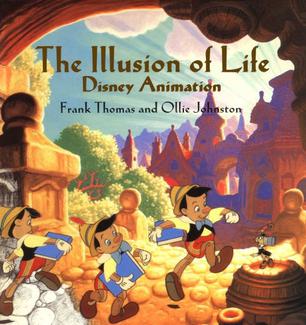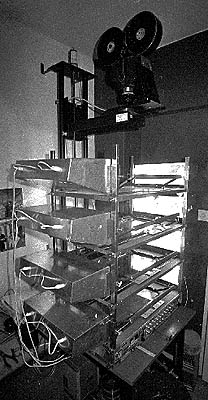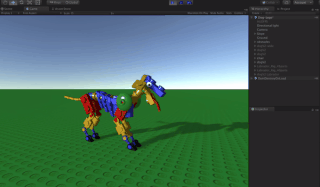
Animation is an audiovisual and artistic medium in which the illusion of movement is achieved without the use of real actors, although the two can overlap. In traditional animation, images are drawn or painted by hand on transparent celluloid sheets (cels) to be photographed and exhibited on film. Animation has been recognized as an artistic medium, specifically within the entertainment industry. Many animations are either tradtional animations or computer animations made with computer-generated imagery (CGI). Stop motion animation, in particular claymation, has continued to exist alongside these other forms.

Computer animation is the process used for digitally generating moving images. The more general term computer-generated imagery (CGI) encompasses both still images and moving images, while computer animation only refers to moving images. Modern computer animation usually uses 3D computer graphics.

Snow White and the Seven Dwarfs is a 1937 American animated musical fantasy film produced by Walt Disney Productions and released by RKO Radio Pictures. Based on the 1812 German fairy tale by the Brothers Grimm, the production was supervised by David Hand, and was directed by a team of sequence directors, including Perce Pearce, William Cottrell, Larry Morey, Wilfred Jackson, and Ben Sharpsteen. It is the first animated feature film produced in the United States and the first cel animated feature film.
Visual effects is the process by which imagery is created or manipulated outside the context of a live-action shot in filmmaking and video production. The integration of live-action footage and other live-action footage or CGI elements to create realistic imagery is called VFX.

Rotoscoping is an animation technique that animators use to trace over motion picture footage, frame by frame, to produce realistic action. Originally, live-action movie images were projected onto a glass panel and traced onto paper. This projection equipment is referred to as a rotoscope, developed by Polish-American animator Max Fleischer. This device was eventually replaced by computers, but the process is still called rotoscoping.

Traditional animation is an animation technique in which each frame is drawn by hand. The technique was the dominant form of animation of the 20th century, until there was a shift to computer animation in the industry, such as digital ink and paint and 3D computer animation.

Franklin Rosborough Thomas was an American animator and pianist. He was one of Walt Disney's leading team of animators known as the Nine Old Men.

Squash and stretch is the phrase used to describe "by far the most important" of the 12 basic principles of animation, described in the book The Illusion of Life by Frank Thomas and Ollie Johnston.

Disney Animation: The Illusion of Life is a book by Frank Thomas and Ollie Johnston, two of the key animators at Disney during the Golden age of American animation.

The multiplane camera is a motion-picture camera that was used in the traditional animation process that moves a number of pieces of artwork past the camera at various speeds and at various distances from one another. This creates a sense of parallax or depth.

Phil Tippett is an American film director and visual effects supervisor and producer, who specializes in creature design, stop-motion and computerized character animation. Over his career, he has assisted ILM and DreamWorks, and in 1984 formed his own company, Tippett Studio.

A procedural animation is a type of computer animation used to automatically generate animation in real-time to allow for a more diverse series of actions than would otherwise be tedious using predefined animations.

Frank and Ollie is a 1995 documentary film about the life and careers of Frank Thomas and Ollie Johnston, two chief animators who had worked at Walt Disney Animation Studios from its early years until their retirement in the late 1970s.

William Norman Ferguson was an American animator for Walt Disney Studios and a central contributor to the studio's stylistic development in the 1930s. He is most frequently noted for his contribution to the creation of Pluto, one of the studio's best-known and most enduring characters, and is the artist most closely associated with that character. He is also credited for developing Peg-Leg Pete and the Big Bad Wolf. Ferguson, known at the studio as "Norm" or "Fergy", was the primary animator of the witch from Snow White and the Seven Dwarfs, the first in a long line of great Disney feature villains. He was also a sequence director on the film.

Disney's twelve basic principles of animation were introduced by the Disney animators Ollie Johnston and Frank Thomas in their 1981 book The Illusion of Life: Disney Animation.[a] The principles are based on the work of Disney animators from the 1930s onwards, in their quest to produce more realistic animation. The main purpose of these principles was to produce an illusion that cartoon characters adhered to the basic laws of physics, but they also dealt with more abstract issues, such as emotional timing and character appeal.

Disney's Nine Old Men were a group of Walt Disney Productions' core animators, who worked at the studio from the 1920s to the 1980s. Some of the Nine Old Men also worked as directors, creating some of Disney's most popular animated movies from Snow White and the Seven Dwarfs to The Rescuers. The group was named by Walt Disney himself, and they worked in both short and feature films. Disney delegated more and more tasks to them in the animation department in the 1950s when their interests expanded, and diversified their scope. Eric Larson was the last to retire from Disney, after his role as animation consultant on The Great Mouse Detective in 1986. All nine members of the group were acknowledged as Disney Legends in 1989 and all would receive the Winsor McCay Award for their lifetime or career contributions to the art of animation.

Anticipation is one of the fundamental 12 basic principles of animation, as set out by Frank Thomas and Ollie Johnston in their authoritative 1981 book on the Disney Studio titled The Illusion of Life. An anticipation pose or drawing is a preparation for the main action of an animated scene, as distinct from the action and the reaction.
Follow through and overlapping action is a general heading for two closely related animation techniques which form part of the 12 basic principles of animation identified by Disney animators Frank Thomas and Ollie Johnston in their authoritative 1981 book on Disney animation, The Illusion of Life. The term drag is sometimes included to form three separate but related concepts in the art of animation.
Creature animation is a specialised part of the animation process which involves bringing realistic animals and creatures to life. It is often distinguished from character animation, which involves breathing life into animated characters and creating the illusion of thought, feeling and emotion.
Straight ahead is a term used in animation that refers to a method that uses only the first key pose of a character, and then continues drawing the character to create the desired motion. It was first referred to in the 1981 book by Ollie Johnson and Frank Thomas The Illusion of Life, and is a part of the 12 Basic Principles of Animation. It contrasts with its converse, pose to pose animation, in that it does not use inbetweening. Straight ahead action is so named because the animator literally works straight ahead from the first drawing of the scene. Disney director-animator Woolie Reitherman said, "When I didn't know what I was doing in an action, I always went straight-ahead. I'd just start on ones. Half the time I didn't know what I was doing. To me, it's fun. You find out something you wouldn't have found out otherwise."















